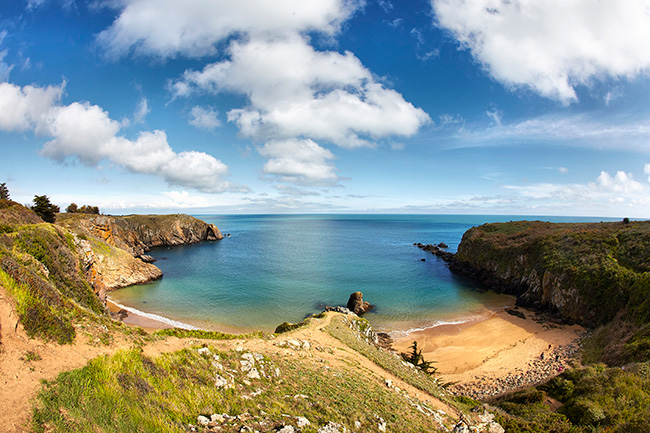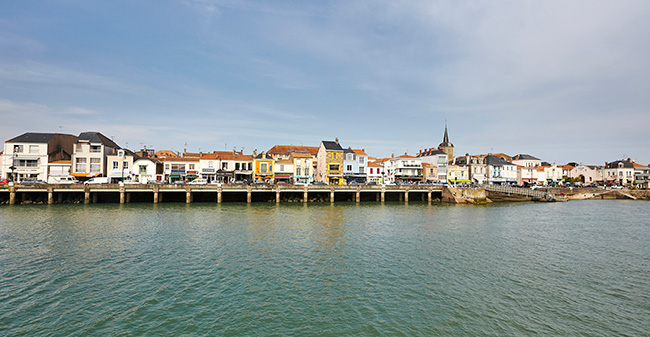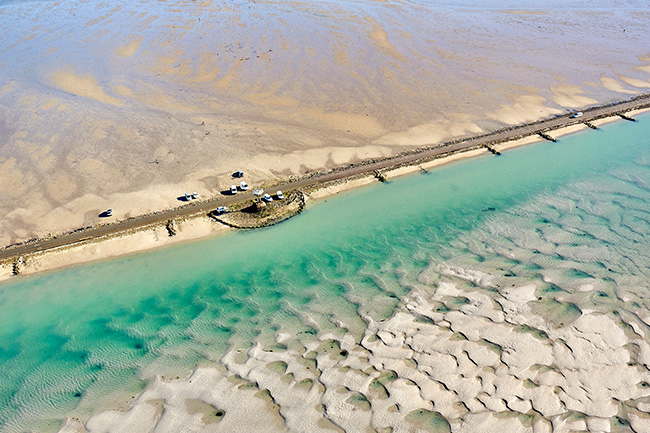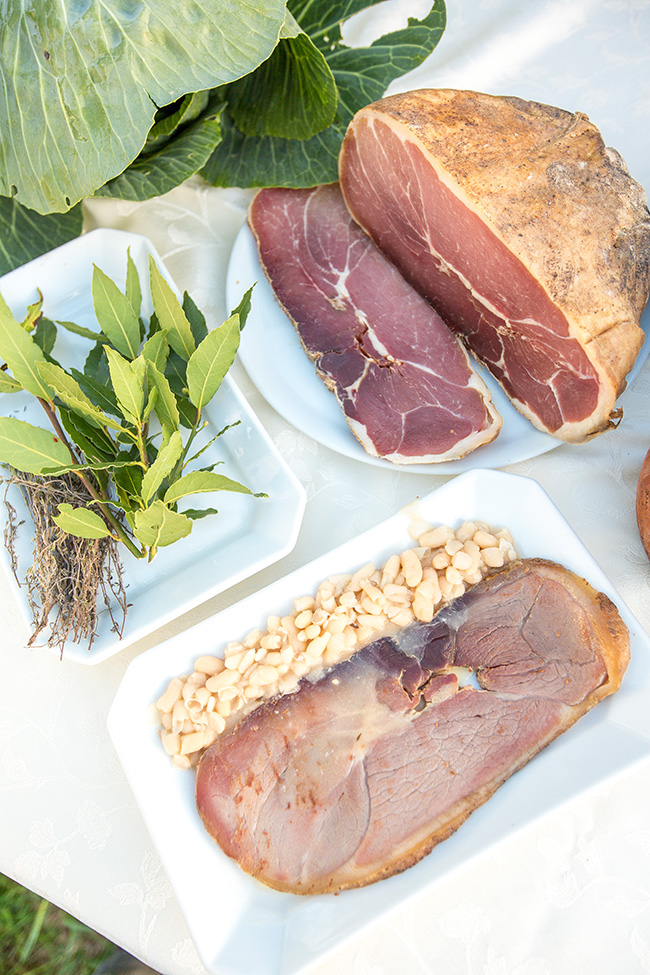10 Reasons to Visit the Vendée
Sponsored

In Western France, on the Atlantic Coast, is the Vendée. Between Nantes and La Rochelle, the department stands out thanks to its accessibility, diversity of landscapes, dynamism, and many leisure activities. The Vendée is an essential international tourist destination for good reason. Here are 10 reasons why you should explore this little corner of paradise.

Wander along the coast © A. Lamoureux
1. The Côte de Lumière: 140 km of Sandy, Sunny Beaches
It is not by chance that it’s called the Côte de Lumière. Indeed, the Vendée coast – which stretches over 250 km – enjoys a sunshine level that is above average for the entire Atlantic coast. With more than 2,300 hours of sunshine a year, the climate of the Vendée is comparable to that of the Southwest. Its 140km of beaches will delight lovers of wild coasts with fine sandy beaches.
In one of the most beautiful bays in the world, it is a delight to enjoy its long and wide stretches of sand. The quality of bathing water is rewarded with a label and in addition, the coast has a low slope. This allows the whole family to spend a safe holiday! Water sports enthusiasts will also find what they are looking for: the Vendée is the favourite playground of surfers and kite-surfers as well as those who enjoy sailing, windsurfing or paddle-boarding, kayaking, etc.

Astounding views © A. Lamoureux
2. Two Beautiful Islands
Attention, change of scenery guaranteed! Head further out to Île-d’Yeu, the jewel of the Atlantic, 17km from the beaches. Concentrated on only 23km of land, the island of Yeu is accessible only by boat and is the furthest from the French Atlantic coast. Nicknamed the Greece of the Vendée, the island hosts a wide variety of landscapes. You can walk from village to village, by bike, on foot or by méhari.
Walking through the narrow streets, enjoy the sight of the pretty white houses with colourful shutters. In front of the dunes, the water of its long beaches is turquoise on summer days. Its cliffs surround pretty coves, a landscape conducive to lazing around with a good book or swimming in the ocean. Fishing also has an active presence on the island with the famous Port de la Meule.
As for Noirmoutier, known as Île aux Mimosas, get ready for unique panoramas. It is worth visiting the authentic natural salt marshes, which produce salt recognised all over the world! More than a hundred sauniers reproduce ancestral processes to extract white gold. Between maritime pine forests and green chains, you will see its famous white beach cabins on one of the must-see spots for learning to sail. In the heart of the island, you will find charming villages and the centre of maritime heritage: the Hotel Jacobsen.

3. Exceptional Seaside Resorts
Among the 18 seaside resorts along the Vendée coast, Saint Jean de Monts is the northernmost. Between nature and urbanity, Saint Jean de Monts is the ideal place for a family holiday. With your feet in the water, try your hand at fishing, have a fun time with your children in one of the many animation spaces, or practice roller skating together on the pier.
In Saint Gilles Croix de Vie, learn more about the history of France’s first sardine port. Stroll through the old town to discover its alleys and villas facing the sea. Appreciate the beauty of Les Sables d’Olonne, the nautical capital, throughout the year! Explore its long beach, port activities and local heritage. Then, head south towards La Tranche-sur-Mer, “Little California”. Known for its beaches lined with dunes and hiking trails, it is a great place to spend an active holiday with friends or family.

Magnificent firework display © Puy du Fou
4. Le Puy du Fou: Voted the Best Park in the World
It’s impossible to come to the Vendée without stopping at Puy du Fou. Embark on a journey back in time, voted several times the best amusement park in the world! Through shows traversing the history of France and the Vendée, you will discover countless adventures spanning the centuries and you will marvel at their grandeur. Ancient villages punctuate the visitors’ itinerary to be enchanted by a festive and playful atmosphere.
The biggest night show in the world, the Cinéscénie, is unveiled from June to September. 3D video projections and special effects await you. In order to extend the experience, 5 hotels are proposed within the park and each one to its particular theme: Villa Gallo-Romaine, the Citadelle, the Clovis Islands, the Camp du Drap d’Or or the new hotel Le Grand Siècle. In 2023, a new show, “Le Mime et l’Etoile”, will be launched: be the first to watch it!

Logis de la Chabotterie © Vendée Tourisme
5. The Bocage: Full of Culture and Heritage
A mecca of Vendée’s heritage and culture, the Bocage, located in the centre of the territory, will satisfy history buffs. From prehistory to the present day, many museums, historic villages, medieval castles and remarkable gardens are worth visiting.
In Vendée, several villages are labelled “Petites Cités de Caractère”, a distinction given to towns with remarkable architectural and landscape heritage. Among them, Mallièvre, the old village of weavers, Mouchamps, the cradle of Clemenceau and the village of artists, Pouzauges and its old castle, and Mortagne sur Sèvre are all picturesque places to discover in the Bocage. To find out more about the wars in the Vendée, head through the doors of an innovative new museum: the Historial de la Vendée. Another unmissable place, the Logis de la Chabotterie and its animations and shows can be visited throughout the year.

Enjoy a family excursion on the water © Vendée Tourisme
6. Marais Poitevin and its Traditions
Located south of the Vendée, the Marais Poitevin is a regional natural park renowned for its unique landscapes that stretch along the Sèvre Niortaise, commonly known as the Venice Verte. The second biggest wetland in France after the Camargue, this timeless environment allows you to connect with nature without any distractions.
Travel along more than 8,000 km of canals, lined with tadpole ash trees, in a traditional boat driven by boatman-guides. Canoeing or stand-up paddle-boarding can also be done on the canal, often in the morning, to enjoy fantastic light. For those who prefer to remain on land rather than go on the water, there’s plenty to do on horseback, on foot or by bike to explore the shore.
During your walk, a stop at one of its villages is strongly recommended. The charm of Romanesque architecture will certainly seduce you, especially the abbeys of Maillezais and Nieul-sur-l’Autise — two treasures of Romanesque art.

Passage of the Gois © A. Lamoureux
7. Unusual: Passage du Gois
A must-see during his stay in the Vendée, the mysterious Passage du Gois attracts all curiosities. It is a legendary 4.5km long road under the sea that comes and goes with the tides. It connects the continent to the island of Noirmoutier from the city of Beauvoir-sur-Mer by joining the city of Barbâtre. You can drive there 1 hour 30 minutes before the hour of low tide and 1 hour 30 minutes after the hour of low tide.
Before the creation of the Noirmoutier bridge, the Gois was the only way to connect the island to the mainland at low tide. For the more daring, a race against the sea is organised every year on the passage: Les Foulées du Gois! By car, on foot or by bike, cross it as you wish, but before you do, don’t forget to read all the information on each end. Along the passage, nine beacons serve as a refuge for the daring individuals who happen to be surprised by the rising waters!

Discover delicious local products © S. Bourcier
8. Renowned Vendée Cuisine
Who said that French food is the best? Vendée is even better! With a rich terroir and a generous ocean, there are myriad local specialities to savour! The Vendée brioche is certainly one of the best known. Its taste is the result of a few high-quality ingredients — flour, butter, sugar and eggs — and a lot of love.
Since the Middle Ages, braided by hand and gilded on the top, the brioche is the pride of the Vendeans. Sweet and fragrant, with brandy or orange blossom water, we like to consume it at breakfast or snack. The oysters “Vendée Atlantique” are also appreciated for their authentic taste and salty aromas. The unique knowledge and skills of Vendée producers are clear and often rewarded. Sardines from Saint Gilles Croix de Vie and mussels from Bouchot are among the tastiest fish and seafood in the country. The préfou, meanwhile, is a “garlic bread” served hot as an accompaniment to the aperitif. Not just butter and garlic, but goat’s cheese, chorizo, and sundried tomatoes…
The Bonnotte de Noirmoutier is another speciality. This small, hand-picked, salted potato has a recognisable taste as it is grown in sandy soil, enriched by seaweed, a mixture of seaweed. Finally, ham-mogettes is an unmissable dish! It is simply a raw ham hand-rubbed with dry salt, sprinkled with brandy and sprinkled with spices and aromas with the iconic white bean (mogette), which we also like to spread on bread rubbed with garlic and butter (salted of course, using the fleur de sel from the area).

Up for a spot of cycling? © S. Bourcier
9. Discover the Vendée by bike
With its 1800km of cycle paths, the Vendée is the perfect terrain for cycling! As a responsible mode of travel, it is a great, low-cost way to travel between towns and villages. Whether it’s cycling on the trails or doing a section of the Vélodyssée – European cycle route – bike travellers will find Accueil Vélo-labelled establishments less than 5km from a bike route.
Among them, there are about a hundred accommodation options (campsites, hotels, gîtes, and B&Bs), 30 tourist offices, 15 bike rental organisations and repairers, and finally, 20 tourist sites. All guarantee a welcoming, high-quality service adapted to your needs. For lovers of French villages, the Vélo Francette also goes to the Vendée, guiding you through the picturesque countryside along the rivers. Saddle up to savour the charms of sweet France!

Set sail or simply observe the competition © Alea
10. Boating and the Everest of the Seas
Among the biggest events hosted in the Vendée, the Vendée Globe is probably the most extraordinary. Known as the ‘Everest of the Seas’, the Vendée Globe is a race of admiration. This sailing race — solo, around the world, non-stop and without assistance — occurs every 4 years. This human adventure is dedicated to the greatest French and foreign sailors.
From Les Sables d’Olonne, the skippers are racing for three months aboard their monohull and have to cross the three major capes: Good Hope (South Africa), Leeuwin (Australia) and Horn (Chile), before going up the Atlantic and completing the world tour at the starting point, after a journey of just over 21,000 nautical miles across the world’s oceans. The Vendée Globe Village is located in Les Sables d’Olonne three weeks before the start, giving the public an opportunity to follow the race preparation and learn more about the world of the sea, while tasting some local specialities.
Find out more: vendee-tourism.co.uk
For great deals and offers, click here.
Lead photo credit : Experience the Vendée's stunning coastline © A. Lamoureux
Share to: Facebook Twitter LinkedIn Email
More in 10 Reasons to Visit the Vendée, best beaches in France, best places to visit in the Vendée, French coastal holidays, Vendée
Leave a reply
Your email address will not be published. Required fields are marked *



